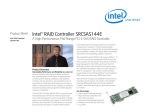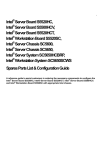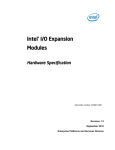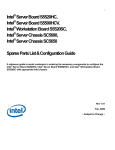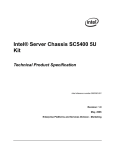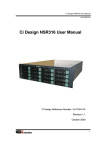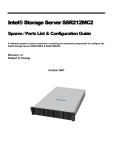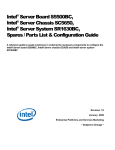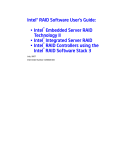Download Intel srcsas144e User's Manual
Transcript
Intel® RAID Controller SRCSAS144E Hardware Guide Intel Order Number: D39308-003 INFORMATION IN THIS DOCUMENT IS PROVIDED IN CONNECTION WITH INTEL(R) PRODUCTS. NO LICENSE, EXPRESS OR IMPLIED, BY ESTOPPEL OR OTHERWISE, TO ANY INTELLECTUAL PROPERTY RIGHTS IS GRANTED BY THIS DOCUMENT. EXCEPT AS PROVIDED IN INTEL'S TERMS AND CONDITIONS OF SALE FOR SUCH PRODUCTS, INTEL ASSUMES NO LIABILITY WHATSOEVER, AND INTEL DISCLAIMS ANY EXPRESS OR IMPLIED WARRANTY, RELATING TO SALE AND/OR USE OF INTEL PRODUCTS INCLUDING LIABILITY OR WARRANTIES RELATING TO FITNESS FOR A PARTICULAR PURPOSE, MERCHANTABILITY, OR INFRINGEMENT OF ANY PATENT, COPYRIGHT OR OTHER INTELLECTUAL PROPERTY RIGHT. Intel products are not intended for use in medical, life saving, life sustaining applications. Intel may make changes to specifications and product descriptions at any time, without notice. Intel is a trademark or registered trademark of Intel Corporation or its subsidiaries in the United States and other countries. *Other names and brands may be claimed as the property of others. Copyright © 2006-2007 by Intel Corporation. Portions Copyright 2005-2007 by LSI Logic Corporation. All rights reserved. ii Intel® RAID Controller SRCSAS144E Hardware Guide Preface This is the primary reference and user’s guide for the Intel® RAID Controller SRCSAS144E, which can be used for SAS and SATA disk drives. It contains installation instructions and specifications. For details on how to configure the storage adapters, and for an overview of the software drivers, see the Software User’s Guide on the Resource CD. Audience This document assumes that you have some familiarity with RAID controllers and related support devices. The people who benefit from this book are: • Engineers who are designing a RAID Controller SRCSAS144E storage adapter into a system. • Anyone installing a RAID Controller SRCSAS144E storage adapter in a RAID system. Organization This document includes the following chapters and appendixes: • Chapter 1 provides a general overview of the Intel® RAID Controller SRCSAS144E. • Chapter 2 describes the procedures for installing the RAID Controller SRCSAS144E storage adapter. • Chapter 3 provides the characteristics and technical specifications for the RAID Controller SRCSAS144E storage adapter. • Appendix A lists and explains the terms and abbreviations used in this manual. Related Publication The Software User’s Guide on the Resource CD that is included with the RAID controller. Intel® RAID Controller SRCSAS144E Hardware Guide iii iv Intel® RAID Controller SRCSAS144E Hardware Guide Contents Preface ........................................................................................................................ iii Audience ............................................................................................................................... iii Organization ......................................................................................................................... iii Related Publication ............................................................................................................... iii Chapter 1, Overview ................................................................................................... 1 Summary of SAS RAID Controller Features .......................................................................... 1 Usability ......................................................................................................................... 2 Redundancy and Error Handling ................................................................................... 3 SAS and SATA Features ............................................................................................... 4 Online Capacity Expansion and RAID Level Migration Rules ....................................... 4 Beep Codes ................................................................................................................... 5 Benefits of Serial Attached SCSI (SAS) ................................................................................ 5 Chapter 2, Intel® RAID Controller SRCSAS144E Hardware Installation ................ 6 Requirements ........................................................................................................................ 6 Installation .............................................................................................................................. 7 Connecting the Cables .......................................................................................................... 9 Configuring the Storage Adapter .........................................................................................11 Replacing a Controller .........................................................................................................12 Resolving a Configuration Mismatch ...................................................................................12 Chapter 3, Intel® RAID Controller SRCSAS144E Characteristics ........................ 13 Technical Specifications ......................................................................................................14 Array Performance Features .......................................................................................15 Fault Tolerance ............................................................................................................16 Electrical Characteristics .............................................................................................16 Safety Characteristics ..................................................................................................17 A. Glossary of Terms and Abbreviations ............................................................... 18 Intel® RAID Controller SRCSAS144E Hardware Guide v vi Intel® RAID Controller SRCSAS144E Hardware Guide Figures Figure 1. Inserting the Intel® RAID Controller SRCSAS144E into a PCI Express* Slot............ 7 Figure 2. Internal SAS Cable for Connection to SAS Backplane or SATA Hard Drives............ 9 Figure 3. SAS and SATA Plugs and SAS Backplane Connector ............................................ 10 Figure 4. Intel® RAID Controller SRCSAS144E to a SATA Hard Drive .................................. 11 Figure 5. Card Layouts............................................................................................................ 13 Intel® RAID Controller SRCSAS144E Hardware Guide vii viii Intel® RAID Controller SRCSAS144E Hardware Guide Tables Table 1. Jumper Descriptions ..................................................................................................13 Table 2. Specifications ............................................................................................................14 Table 3. Array Performance Features .....................................................................................15 Table 4. Fault Tolerance Features ..........................................................................................16 Table 5. Electrical Characteristics ...........................................................................................16 Intel® RAID Controller SRCSAS144E Hardware Guide ix 1 Overview This chapter provides a general overview of the Intel® RAID Controller SRCSAS144E. It consists of the following sections: • Summary of SAS RAID Controller Features • Benefits of Serial Attached SCSI (SAS) The Intel® RAID Controller SRCSAS144E Storage Adapter is a high-performance intelligent PCI Express* SAS RAID controller. It provides reliability, high performance, and fault-tolerant disk subsystem management. This is an ideal RAID solution for the internal storage needs of workgroup, departmental, and enterprise systems. The RAID Controller SRCSAS144E offers a cost-effective way to implement RAID in a server for internal and external storage. The SAS controller allows you to use SATA and SAS hard disk drives in the same system, so you can take advantage of the benefits of each type of drive. The controller can connect up to eight drives directly and use expanders to connect to additional drives. See the ANSI SAS standard, version 1.0 specification for more information about the use of expanders. As the second generation PCI Express storage adapter, the RAID Controller SRCSAS144E addresses the growing demand for increased data throughput and scalability requirements across midrange and enterprise-class server platforms. Simplified cabling between drives is an additional benefit. The optional Intel® RAID Smart Battery for cached data protection allows system builders to protect cached data during catastrophic system failures. Summary of SAS RAID Controller Features Note: In this document, the term low-profile refers to the height, not the length, of a PCI add-in card. The Intel® RAID Controller SRCSAS144E is an intelligent low-profile RAID adapter with: • An Intel® IOP333 I/O processor running at 500 MHz. • An LSI 1068 SAS (including SATA) controller. • 128 MB RAM. • Eight independent ports: — Four internal ports provided via the SFF8087 connector. — Four external ports provided via the SFF8470 connector. • Support for both enterprise-class SAS devices and desktop-class SATA drives. 1 Intel® RAID Controller SRCSAS144E Hardware Guide • Support for up to 32 SAS or SATA drives and 40 logical drives. • PCI Express* connector that fits into a x8 PCI Express slot capable of 2.5 Gbps per lane over PCI Express x1, or x4. • 3.0 Gbps point-to-point transfer rate. • Both a standard and a low-profile bracket. The SAS controller supports the ANSI Serial Attached SCSI (SAS) standard, version 1.0. In addition, the controller supports the Serial ATA (SATA) protocol defined by the Serial ATA specification, version 1.0a.T he SAS controller is a versatile controller that supporting both the SAS and SATA interfaces and provides the backbone of both server and high-end workstation environments. Protocols supported include: • Serial SCSI Protocol (SSP): Communication with other SAS devices. • SATA II Protocol: Communication with other SATA II devices. • Serial Management Protocol (SMP): Topology management information sharing with expanders. • Serial Tunneling Protocol (STP) support for SATA II through expander interfaces. Usability • Smaller, thinner cabling with serial point-to-point 3.0 Gbps data transfer rates. • Allows mixed connections to SAS or SATA targets. • Support for non disk devices and mixed capacity drives. • Support for intelligent XOR RAID levels 0, 1, 5, 10, and 50. • Dedicated or global hot spare with auto rebuild if an array drive fails. • User defined stripe size per drive (8, 16, 32, 64 (def), or 128 KB). • Advanced array configuration and management utilities that provide: — Online Capacity Expansion (OCE) adds space to existing drive or new drive. — Online RAID level migration (upgrade of RAID mode, may require OCE). — Drive migration. — Drive roaming. — No reboot necessary after expansion. • An upgradeable Flash ROM interface. • Allows for staggered spin up, hot plug, lower power consumption. Intel® RAID Controller SRCSAS144E Hardware Guide 2 • User specified rebuild rate (% of system resources to use from 0-100%). Warning: Exceeding 50% rate may cause operating system errors caused by waiting for controller access. • Background operating mode can be set for rebuilds, consistency checks, initialization (auto restarting consistency check on redundant volumes), migration, OCE, and patrol read. Redundancy and Error Handling • Enclosure management support, including LEDs. • Activity and fault indicators per drive, port selector (dual-port drives). • Drive coercion (auto resizing to match existing disks). • Auto-detection of failed drives with transparent rebuild. Disk activity (I/O to the drive) must be present for a missing drive to be marked as failed. • Auto-resume on reboot of initialization or rebuild (must be enabled before virtual disk creation). • Smart initialization automatically checks consistency of virtual disks if there are five or more disks in a RAID 5 array which optimizes performance by enabling readmodify-write mode. RAID 5 arrays of only three or overdrives use peer read mode. • Dirty cache LED plus cache write to disk error reporting. • Smart Technology predicts failures of drives and electronic components. • Patrol Read checks drives and maps bad sectors. • Commands are retried at least four times. • Firmware provides best effort to recognize an error and recover from it if possible. • Failures are logged from controller and drive firmware, SMART monitor, SAF-TE controller. • Failures are logged in NVRAM, viewable from OS Event Log, Intel® RAID Web Console 2; CIM, LEDs, and via alarm. • Multiple cache options provide choice of speed, redundancy: — Write: The data written / (done) signal is returned when data is written to drive or only to cache: ^ Write-back (default): Faster, because it since doesn't wait for the disk, but data will be lost if power is lost. ^ Write-through: Slower, but ensures data is on the disk. — Read Ahead: Predicts the next read will be sequential and buffers this data into the cache: 3 ^ NonRead Ahead: Always reads from the drive after determining the exact location of each read. ^ Adaptive Read Ahead: Will read ahead and cache data only if doing sequential reads. Intel® RAID Controller SRCSAS144E Hardware Guide — I/0 setting: Determines whether to read/write from cache to improve performance: ^ Cache I/O: Writes to the cache and next read checks the cache first. ^ Direct I/O: Never uses cache, all data goes from host to disk to host. • Redundancy through: — Configuration stored in nonvolatile RAM and on the drives (COD). — Hot swap support. — Optional battery backup for cache memory. Controller provides fast or trickle charges. SAS and SATA Features • Provides eight independent phys, each supporting 3.0 Gbps and 1.5 Gbps SAS and SATA data transfers. • Scalable interface that supports up to 15 SATA devices, 40 logical devices, or 32 SAS devices via expanders. • Transfers data using SCSI information units. • Supports SSP to enable communication with other SAS devices. • Supports SMP to communicate topology management information. • Supports single PHY or wide ports consisting of 2, 3, or 4 PHY within a single quad port. • Allows addressing of multiple SATA targets through an expander if using SATA 2.0compliant hard disk drives. • Allows multiple initiators to address a single target (in a fail-over configuration) through an expander. Online Capacity Expansion and RAID Level Migration Rules • Migration must occur to the same or larger capacity configuration. • Migration cannot occur if there is more than one virtual disk in a logical array. • Migration and OCE cannot be done on Spanned Arrays (RAID 10, 50). • Migrations supported are: RAID 1 to RAID 0, RAID 5 to RAID 0. • With OCE, migrations supported are RAID 0 to RAID 1, RAID 0 to RAID 5, RAID 1 to RAID 5. Intel® RAID Controller SRCSAS144E Hardware Guide 4 Operating System Support The RAID Controller SRCSAS144E supports major operating systems, including: • Windows 2000*, Windows Server 2003*, and Windows XP* • Red Hat* Enterprise Linux 3.0 and 4.0 • SuSe* Linux Enterprise Server 9 and 9 SP1 Note: The operating systems supported by this controller may not be supported by your server board. See the tested operating system list for your server board at http://support.intel.com/support/motherboards/server/. See also the tested hardware and operating system list for the RAID Controller SRCSAS144E to make sure the RAID card supports your operating system. Beep Codes • Short beep, 1 second on, 1 second off: The array is degraded, but no data is lost • Long beep, 3 seconds on, 1 second off: The array has failed and data has been lost. • Short beep, 1 second on, 3 seconds off: Using hot spare in rebuild. The alarm will continue during the rebuild with a different sound at completion. To disable the alarm, choose Disable Alarm. To disable the alarm only until the next event or until the next power cycle, choose Silence Alarm. To enable the alarm, choose Enable Alarm. Benefits of Serial Attached SCSI (SAS) SAS is a serial, point-to-point, enterprise-level device interface that leverages the proven SCSI protocol set. SAS is a convergence of the advantages of SATA, SCSI, and FC, and is the future mainstay of the enterprise and high-end workstation storage markets. SAS offers a higher bandwidth per pin than parallel SCSI, and improves signal and data integrity. The SAS interface uses the proven SCSI command set to ensure reliable data transfers, while providing the connectivity and flexibility of point-to-point serial data transfers. The serial transmission of SCSI commands eliminates clock skew challenges. The SAS interface provides improved performance, simplified cabling, smaller connectors, lower pin count, and lower power requirements when compared to parallel SCSI. SAS controllers leverage a common electrical and physical connection interface that is compatible with Serial ATA technology. The SAS and SATA protocols use a thin, 7-wire connector instead of the 68-wire SCSI cable or 40-wire ATA cable. The SAS/SATA connector and cable are easier to manipulate, allow connections to smaller devices, and do not inhibit airflow. The point-to-point SATA architecture eliminates inherent difficulties created by the legacy ATA master-slave architecture, while maintaining compatibility with existing ATA firmware. 5 Intel® RAID Controller SRCSAS144E Hardware Guide 2 Intel® RAID Controller SRCSAS144E Hardware Installation This chapter describes the procedures used to install the Intel® RAID Controller SRCSAS144E with internal and external connectors. Requirements The following items are required to install a RAID Controller SRCSAS144E: • An Intel® RAID Controller SRCSAS144E. • A host system with an available x4 or x8 bi-directional PCI Express* slot. • The Resource CD, which contains drivers and documentation. • The cables provided with the RAID controller. • SAS or SATA hard disk drives. Intel Corporation strongly recommends using an uninterruptible power supply (UPS). Intel® RAID Controller SRCSAS144E Hardware Guide 6 Installation 1. Power off the computer and all drives, enclosures, and system components. Remove the power cord from the computer. 2. Remove the chassis cover and access the PCI Express add-in card slots. See your server chassis documentation for instructions. 3. Align the controller’s connector with a x4 or x8 PCI Express* slot on the server board. 4. Press down gently but firmly to ensure that the card is properly seated in the slot, as shown in Figure 1. Secure the bracket to the computer chassis. AF000645 Figure 1. Inserting the Intel® RAID Controller SRCSAS144E into a PCI Express* Slot 5. Connect the provided internal and/or external cables into the adapter using the 4-port combined end. Make sure the controller and cables are properly attached. — If using an external cable, plug the cable into the connector in the end bracket. — If using an internal cable, plug the cable into connector at the inside edge of the adapter. 7 Intel® RAID Controller SRCSAS144E Hardware Guide Note: System throughput problems can occur if using SAS cables that do not come with the RAID controller and that are not the correct type. To minimize the potential for problems: - Use cables no longer than ten meters for SAS and one meter for SATA. It is better to use the shortest possible cables. The cable length should be reduced by about one foot (.33 meters) if using a backplane. - You may connect one device per SATA/SAS cable either as a device or as an expander. - Route SAS cables carefully. - Use only “straight” SAS cables, not “cross-over” SAS cables. 6. Replace components you needed to remove to access the PCI Express add-in card slot. See your server chassis documentation for instructions. 7. Reinstall the chassis cover and reconnect the power cord(s). See your server chassis documentation for instructions. 8. Reconnect any peripheral items you needed to disconnect. 9. Turn the power on to the server and hard drives. As the server powers up, listen to be sure that the SAS and SATA devices are powered up before or at the same time as the computer boots. 10. Watch the boot process until you see a BIOS message to inform you of the key combination to press to enter the RAID BIOS Console. It will look similar to the following message: Press <CTRL><G> to run BIOS Console 2. This message will time out after several seconds and pass the option to get into the BIOS Console. The firmware takes several seconds to initialize and will then display the RAID Controller SRCSAS144E number and firmware version. The numbering of the controllers follows the PCI slot scanning order used by the server board. Intel® RAID Controller SRCSAS144E Hardware Guide 8 Connecting the Cables This section describes the cables used on the SAS controller and provides instructions for connecting SAS and SATA hard disk drives to the SAS RAID controller. Note: Use only “straight” SAS cables, not “cross-over” SAS cables. Figure 2 shows the cable used to connect the internal connectors on a SAS RAID controller to SATA drives. The cable supplied with the Intel® RAID Controller SRCSAS144E is for SATA drives or a SAS backplane connection. HDD Connector Serial Signal Cables RSA to HDD Breakout Cable Figure 2. Internal SAS Cable for Connection to SAS Backplane or SATA Hard Drives 9 Intel® RAID Controller SRCSAS144E Hardware Guide A SATA connector consists of a signal connector and a power connector. The SAS connector adds a bridge (primary physical link) between the signal connector and the power connector. This means SAS backplane connectors can accept either drive type, but SATA backplane connectors can ONLY accept SATA drives. Figure 3 shows these connectors. Physical Link Serial Att ached SCSI Power SAS Backplane Recept acle Connector SAS Primary Physical Link Power Serial A TA Power SATA Physical Link SAS Secondary Physical Link SATA/SAS Primary Physical Link Note: SA TA backplane connectors will NOT accept SAS drives Figure 3. SAS and SATA Plugs and SAS Backplane Connector Intel® RAID Controller SRCSAS144E Hardware Guide 10 Perform the following steps to connect a RAID Controller SRCSAS144E directly to a SAS backplane or to SATA hard drives. When cabling directly to hard drives or to backplanes that do not include expander support, use one cable per drive. When cabling to backplanes that include expander support, use one or two cables per backplane. 1. Connect the 4-port connector on the internal cable into the connector on the RAID Controller SRCSAS144E. 2. Connect between one and four of the connectors on the other end of the cable into the connector on a SAS backplane or SATA hard drive, or into a backplane that has expander support (Intel product codes AXX6DRV3GEXP or AXX4DRV3GEXP). Figure 4. Intel® RAID Controller SRCSAS144E to a SATA Hard Drive Configuring the Storage Adapter After performing the Intel® RAID Controller SRCSAS144E installation, you must configure the storage adapter and install the operating system driver. The Software User’s Guide instructs you on the configuration options and how to set them on your RAID Controller SRCSAS144E, and provides detailed installation instructions for operating system drivers. 11 Intel® RAID Controller SRCSAS144E Hardware Guide Replacing a Controller Perform the following steps to replace a failed controller. 1. Power off the computer and all drives, enclosures, and system components. Remove the power cord. 2. Remove the chassis cover and access the PCI Express add-in card slots. See your server documentation for instructions. 3. Disconnect the cable(s) from the RAID controller. 4. Remove the failed controller from the system. 5. Insert the replacement controller into the system. Follow the instructions under Installation. Resolving a Configuration Mismatch If a replacement RAID Controller SRCSAS144E has a previous configuration, a message displays during POST stating that there is a configuration mismatch. A configuration mismatch occurs when the configuration data in the NVRAM and the hard disk drives are different. You need to update the configuration data in the NVRAM with the data from the hard disk drive. Perform the following steps to resolve the mismatch. 1. Press <Ctrl> <G> when prompted during the boot process to access the BIOS Configuration Utility. 2. Select Configure—>View/Add Configuration. This allows viewing of the NVRAM and drive configurations. 3. Select the configuration on disk because the drives contain the correct configuration. 4. Press <Esc> and select YES to update the NVRAM. 5. Exit and reboot. Intel® RAID Controller SRCSAS144E Hardware Guide 12 3 Intel® RAID Controller SRCSAS144E Characteristics This chapter describes the characteristics of the Intel® RAID Controller SRCSAS144E. Figure 5 displays the connectors and headers on the controller and Table 1 describes them. Figure 5. Card Layout s Table 1. Jumper Descriptions Jumper Description Type Comments J4 Flash Recovery jumper 2-pin If a normal firmware update fails, place a jumper across the J4 pins and reflash. The card will not function as a controller until the jumper is removed. J5 Port activity LED 8x2 header LED signal for activity per port for eight ports. J6 SAF-TE I2C header 3-pin SAF-TE Enclosure management support. Warning: Do not connect to a non-expander SAS backplane or data loss may occur. 13 J7 SES I2C header J8 Cache write pending LED SES2 Enclosure management support. 2-pin Provides a signal indicating the cache has data to write. Intel® RAID Controller SRCSAS144E Hardware Guide Table 1. Jumper Descriptions Jumper J9 Description Drive fault LEDs Intel® RAID Smart Battery connector J11 Type Comments 8x2 header LED signal on drive fault per port for eight ports. 20-pin Cable connector for the battery pack. This is located on the back (non-connector) side of the board. Warning: May not display correctly if only internal ports are used. Technical Specifications The design and implementation of the Intel® RAID Controller SRCSAS144E minimizes electromagnetic emissions, susceptibility to radio frequency energy, and the effects of electrostatic discharge. See the appendices for regulatory marks and certifications. Table 2 lists the specifications for the Intel® RAID Controller SRCSAS144E. Table 2. Specifications Intel® RAID Controller SRCSAS144E Specification Processor Intel® 80333 I/O processor at 500 MHz (PCI Controller) Operating Voltage +3.3 V, +12 V Card Size Low-profile PCI Express* adapter card size (7.71 inches by 2.535 inches) Array Interface to Host PCI Express* Rev 1.0A, x4 lane width 2.5 Gbps SAS Bus Speed 3 GBps per port, point-to-point SAS Controller One LSI SAS 1068 controller SAS / SATA Ports 1x4 internal ports, 1x4 external ports. Supports 32 SAS/SATA devices using expanders, 40 virtual disks. Cache Integrated 128 MB RAM, optional battery backup Firmware 4 MB in reflashable flash ROM Compatible Devices Mixed capacity, mixed SATA and SAS in different enclosures; non-disk devices, including expanders. Cabling Small, thin cables do not restrict airflow; shared connectors for multiple drive types. Intel® RAID Controller SRCSAS144E Hardware Guide 14 Table 2. Specifications Intel® RAID Controller SRCSAS144E Specification Redundant Configuration 32 Kb NVRAM and config on disk (COD) store RAID configuration. Enclosure Management I2C out-of-band, SES2 in-band, SAF-TE (LEDs) Array Performance Features Table 3 shows the RAID Controller SRCSAS144E array performance features. Table 3. Array Performance Features Intel® RAID Controller SRCSAS144E Specification 15 PCI Express* Host Data Transfer Rate 2.5 Gigabit/s per lane Drive Data Transfer Rate 3 Gigabit/s per lane Maximum Scatter/Gathers 26 elements Maximum Size of I/O Requests 6.4 Mbytes in 64 Kbyte stripes Maximum Queue Tags per Drive As many as the drive can accept Stripe Sizes 8, 16, 32, 64, or 128 Kbyte Maximum Number of Concurrent Commands 255 Support for Multiple Initiators Yes Flexibility Drive migration, RAID level migration; drive roaming online capacity expansion, without reboot Background Services Rebuild, consistency check, initialization, migration, OCE, and patrol read Cache Options Write-back or write-through, read ahead, adaptive read ahead, non-read ahead, cache I/O or direct I/O Intel® RAID Controller SRCSAS144E Hardware Guide Fault Tolerance Table 4 shows the RAID Controller SRCSAS144E fault tolerance features. Table 4. Fault Tolerance Features Specification Intel® RAID Controller SRCSAS144E Self Monitoring Analysis and Reporting Technology (SMART) support Detects up to 70% of all predictable disk drive failures and monitors the internal performance of all motors, heads, and drive electronics. Optional Battery Backup Intel® RAID Smart Battery cache backup. Up to 64 hours of data retention. Trickle / fast charging. Charge indicator. Drive Replacement Auto detection of hard drive failure; hot-plug, hot-swap. User set rebuild rate. Drive Rebuild Using Hot Spares Automatic at drive failure; dedicated per array; global per array; autoresume of initialization or rebuild on reboot Error Checking and Indication Parity generation and checking, automatic consistency checking; patrol reads; activity and fault LEDs Power Conservation Staggered spin-up, lower power requirements. Electrical Characteristics This section provides the power requirements for the RAID Controller SRCSAS144Es. Table 5 lists the maximum power requirements. Table 5. Electrical Characteristics PCI / PCI Express* / Express +12 V 115 mA; used only if battery is present PCI / +5.0 V 1.5 A (PCI only) Intel® RAID Controller SRCSAS144E Hardware Guide PCI / PCI Express / Express +3.3 V N/A PCI PRSNT1# / 2# Power 15.6 W Operating Range Temperature 0° C to 45° C 18.3 W with battery charging 16 Thermal and Atmospheric Characteristics The thermal and atmospheric characteristics are: • Relative humidity range: 5% to 90% non-condensing • Maximum dew point temperature: 32° C • Airflow must be at least 300 linear feet per minute (SFPM) to avoid operating the 80333 processor above the maximum ambient temperature The storage and transit environment conditions are: • Temperature range from -30° C to 80° C (dry bulb) without battery, 0° C to 45° C (dry bulb) with battery. • Relative humidity range: 5% to 90% non-condensing Safety Characteristics The RAID Controller SRCSAS144E meets or exceeds the requirements of UL flammability rating 94 V0. Each bare board is also marked with the supplier name or trademark, type, and UL flammability rating. For the boards installed in a PCI Express* bus slot, all voltages are lower than the SELV 42.4 V limit. The design and implementation minimizes electromagnetic emissions, susceptibility to radio frequency energy, and the effects of electrostatic discharge. The adapter carries the CE mark, C-tick mark, FCC self-certification logo, Canadian compliance statement, Korean MIC, Taiwan BSMI, and Japan VCCI. The adapter meets the requirements of CISPR Class B. Both the adapter and battery are CCSA C22.2, No. 60950-1, UL60950-1 First Edition listed accessory, UL filenumber E257743. 17 Intel® RAID Controller SRCSAS144E Hardware Guide A Glossary of Terms and Abbreviations BIOS Basic Input/Output System. Software that provides basic read/write capability. Usually kept as firmware (ROM based). The system BIOS on a server board is used to boot and control the system. The BIOS on your host adapter acts as an extension of the system BIOS. Configuration The way a computer is setup; the combined hardware components (computer, monitor, keyboard, and peripheral devices) that make up a computer system, and the software settings that allow the hardware components to communicate with each other. Device Driver A program that allows a microprocessor (through the operating system) to direct the operation of a peripheral device. Domain Validation A software procedure in which a host queries a device to determine its ability to communicate at the negotiated data rate. EEPROM Electronically Erasable Programmable Read-Only Memory. A memory chip typically used to store configuration information. It provides stable storage for long periods without electricity and can be reprogrammed. See NVRAM. External SAS Device A SAS device installed outside the computer cabinet. These devices are connected together using specific types of shielded cables. Host The computer system in which a storage adapter is installed. It uses the storage adapter to transfer information to and from devices attached to the SCSI bus. Host Adapter Board (HAB) A circuit board or integrated circuit that provides a device connection to the computer system. Internal SAS Device A SAS device installed inside the computer cabinet. These devices are connected together using an unshielded ribbon cable. Main Memory The part of a computer’s memory which is directly accessible by the CPU (usually synonymous with RAM). NVRAM Non-volatile Random Access Memory. An EEPROM (Electronically Erasable Read-Only Memory chip) used to store configuration information. See EEPROM. Peripheral Devices A piece of hardware (such as a video monitor, disk drive, printer, or CD-ROM) used with a computer and under the computer’s control. SCSI peripherals are controlled through a SAS Intel® RAID Controller SRCSAS144E. Intel® RAID Controller SRCSAS144E Hardware Guide 18 SAS Serial Attached SCSI. A serial, point-to-point, enterprise-level device interface that leverages the proven SCSI protocol set. The SAS interface provides improved performance, simplified cabling, smaller connections, lower pin count, and lower power requirements when compared to parallel SCSI. SAS controllers leverage a common electrical and physical connection interface that is compatible with Serial ATA. The SAS controllers support the ANSI Serial Attached SCSI standard, version 1.0. In addition, the controller supports the Serial ATA (SATA) protocol defined by the Serial ATA specification, version 1.0a. Each port on the SAS RAID controller supports SAS and SATA devices. SAS Device Any device that conforms to the SAS standard and is attached to the SAS bus by a SAS cable. This includes SAS storage adapters (host adapters) and SAS peripherals. 19 Intel® RAID Controller SRCSAS144E Hardware Guide




























